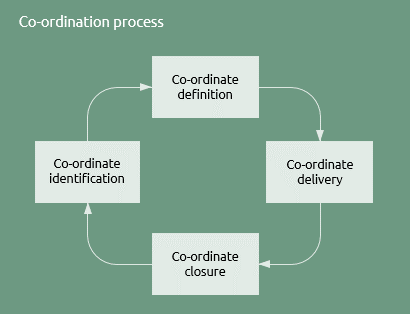While the management process shapes and adjusts the portfolio, this process deals with the day-to-day co-ordination of its component projects and programmes. The two processes are closely aligned. While management process sets parameters within which the co-ordination is performed, the information produced by the co-ordination will inform the on-going prioritisation and balancing.
The goals of this process are to:
- consolidate information from the component projects and programmes to understand the portfolio as a whole;
- monitor the performance of the portfolio against its objectives;
- manage the inter-relationships between projects and programmes.
At any given point in time, the portfolio will contain inter-related projects and programmes at all stages of the life cycle. In reality, the co-ordination involves projects in definition, programmes in delivery, projects in closure and programmes in identification etc.
The diagram and activities as described below are a simplification of the process designed to facilitate discussion of what needs to be done.
Click on the components of the diagram for more detail

Co-ordinate identification
The project or programme identification process starts with a mandate and concludes with a brief. This will include high level requirements management and solutions development where project and programme teams are working with stakeholders. The portfolio may need to co-ordinate this to ensure stakeholders are not burdened with simultaneous demands from multiple projects.
In some contexts this is entirely handled by client organisations and the portfolio management team simply have to review externally produced briefs (or their equivalent) and integrate these into the portfolio.
In structured portfolios the portfolio management team will need to decide whether they simply issue a mandate or perform identification themselves and kick projects and programmes off with a brief, i.e. start projects and programmes at the definition phase.
This depends entirely on the context. Some portfolios have a set of high level strategic objectives and will delegate much of the responsibility for designing ways of achieving those objectives. Others will have more clearly defined and delineated objectives where it makes more sense to start work off with highly co-ordinated project and programme briefs.
Where the project and programme briefs are produced by the corresponding project and programme management teams, the portfolio management team must review these in the context of all other projects and programmes in the portfolio.
High level plans and business cases must be reviewed for their impact on other plans and business cases. What may work perfectly well in isolation may not work so well in concert with the rest of the portfolio. Conversely, the portfolio management team may identify opportunities in a new brief to enhance other projects or programmes.
Back to diagram
Co-ordinate definition
In some cases the definition phase is also performed by a client organisation, in which case the portfolio management team must review the definition documentation and consider the impact on the existing portfolio.
The definition of a project or programmes can be a substantial piece of work in its own right. Where this is performed within the portfolio, the management team must confirm that competent resources can be made available since this may impact on other projects and programmes.
As with identification, the portfolio management team need to monitor the impact that combined definition phases may have on individual or small groups of stakeholders.
Back to diagram
Co-ordinate delivery
This is where the bulk of co-ordination will take place. The portfolio management team must retain an overview of progress across all projects and programmes and have a clear understanding of any interdependencies between them.
Once issues and their impact are understood, the portfolio management team must act accordingly. This can involve adjusting budgets, redeploying resources, accelerating or decelerating work or even recommending the termination of a project or programme.
Back to diagram
Co-ordinate closure
A key part of closure is the demobilisation of a project or programme’s infrastructure, including disposal of assets and redeployment of staff. The portfolio management team should work closely with the project and programme management teams leading up to closure so that this is managed to the benefit of other projects and programmes in the portfolio.
Back to top





